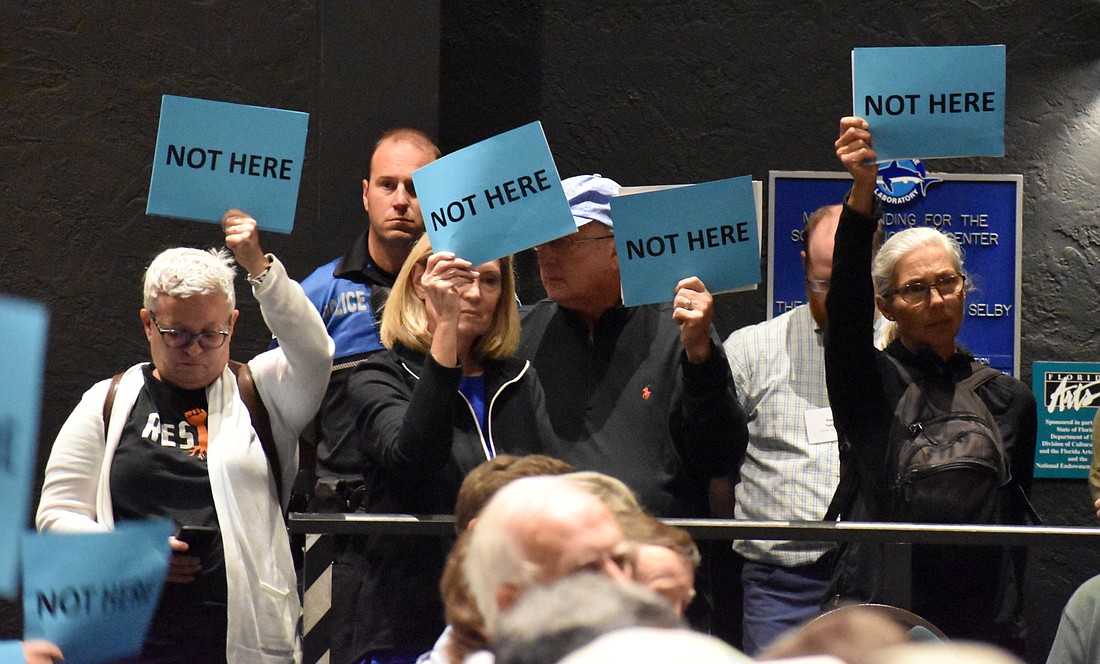- January 4, 2025
-
-
Loading

Loading

Red tide fears led the discussion as hundreds of Florida residents gathered at Mote Marine Lab and Aquarium on Tuesday night to express support or disdain for a fish farm proposed to be assembled and run off the Sarasota coast in the Gulf of Mexico.
A Hawaii-based company, Kampachi Farms, wants to host 20,000 almaco jack in a pen suspended in the Gulf of Mexico. To do so, it would need a permit from the Environmental Protection Agency.
The EPA held a hearing on the topic, which attracted more than 100 people and 60 speakers. Most of them opposed the project.
The project would place a pen about 45 miles southwest of Sarasota and produce a maximum annual harvest of 88,000 pounds, according to the permit draft. If approved, it would be the first finfish project in the Gulf of Mexico and the first in federal waters in the contiguous 48 states.
Many residents expressed concerns that the project would upset the Gulf ecosystem and pave the way for future farms.
Resident Ken Jaros questioned whether allowing the program that has the potential to release pollutants into the Gulf was the best move for a body of water already fraught with harmful red tide blooms.
He cited the millions of pounds of dead sea life that washed on Florida shores during the 2018 red tide bloom.
“We should be asking the question: Do we need more daily pollution from fish food and the waste it becomes?” Jaros said. “Do we really want to directly discharge toxins like the untreated fish waste and pharmaceuticals for the financial gain of a few individuals?”
However, supporters of the projects said that many criticisms of the farm were based on antiquated fish farming practices.
Dennis Peters, project manager and permit coordinator, said that in preparation for the project, Kampachi met with various organizations, which allowed the company to highlight 18 possible sites.
He said the group selected this site because it has the appropriate water, depth, substrate and temperature regimes. It also allows the company to avoid sensitive reef habitats and endangered species, Peters said, which will allow the company to run the project with minimal impacts.
“Although aquaculture in federal waters is a new industry in [the Gulf], there is already plenty of sound science that shows when net pens are inserted correctly in deeper water farther offshore and when these systems are managed according to well-established practices, there are no significant impacts on water quality, sea form habitats or on the wild fish or other wildlife around the net pens,” Peters said.
As part of the permit’s requirements, Kampachi would have to monitor several factors, such as medicinal products used on the fish and discharges of pollutants including chlorophyll, copper, phosphorus, sulfide and nitrogen.
If approved, Mote will provide Kampachi with fingerling almaco jack raised at its research park.
Although many residents stood firmly on one side of the issue or the other, some offered suggestions to improve the project.
Environmental consultant Sean Patton suggested rather than solely farming the almaco jack, Kampachi should do an ecosystem-based farming project that would also grow macroalgae or other organisms that could help clean the Gulf’s waters.
“If we just block every project that comes our way, we’ll never get anywhere,” Patton said. “But imagine if we took this warm, salty, shallow waters that we know grow a lot of harmful algae and instead grew algae that we could eat. Imagine at the same time you were doing this aquaculture project and making money and driving our economy, you were improving the water quality.”
The facility would include a support vessel and one floating cage at a depth of 130 feet.
Residents have until Feb. 4 to email comments to: [email protected].
If the EPA approves, the project also would need a permit from the U.S. Army Corps of Engineers.